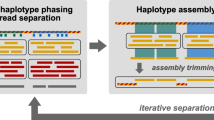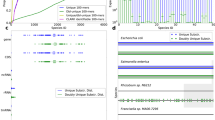Abstract
With the massive data generated by the Human Microbiome Project, how to transform such data into useful information and knowledge remains challenging. Here, with currently available sequencing information (reference genomes and metagenomes), we have developed a comprehensive microarray, HuMiChip2, for strain-level identification and functional characterization of human microbiomes. HuMiChip2 was composed of 29,467 strain-specific probes targeting 2063 microbial strains/species and 133,924 sequence- and group-specific probes targeting 157 key functional gene families involved in various metabolic pathways and host-microbiome interaction processes. Computational evaluation of strain-specific probes suggested that they were not only specific to mock communities of sequenced microorganisms and metagenomes from different human body sites but also to non-sequenced microbial strains. Experimental evaluation of strain-specific probes using single strains/species and mock communities suggested a high specificity of these probes with their corresponding targets. Application of HuMiChip2 to human gut microbiome samples showed the patient microbiomes of alcoholic liver cirrhosis significantly (p < 0.05) shifted their functional structure from the healthy individuals, and the relative abundance of 21 gene families significantly (p < 0.1) differed between the liver cirrhosis patients and healthy individuals. At the strain level, five Bacteroides strains were significantly (p < 0.1) and more frequently detected in liver cirrhosis patients. These results suggest that the developed HuMiChip2 is a useful microbial ecological microarray for both strain-level identification and functional profiling of human microbiomes.




Similar content being viewed by others
References
Ahn TH, Chai J, Pan C (2015) Sigma: strain-level inference of genomes from metagenomic analysis for biosurveillance. Bioinformatics 31(2):170–177
Anderson MJ (2001) A new method for non-parametric multivariate analysis of variance. Austral Ecol 26(1):32–46
Bajaj JS, Heuman DM, Hylemon PB, Sanyal AJ, White MB, Monteith P, Noble NA, Unser AB, Daita K, Fisher AR (2014) Altered profile of human gut microbiome is associated with cirrhosis and its complications. J Hepatol 60(5):940–947
Bunout D (1999) Nutritional and metabolic effects of alcoholism: their relationship with alcoholic liver disease. Nutrition 15(7–8):583–589
Caporaso JG, Lauber CL, Costello EK, Berg-Lyons D, Gonzalez A, Stombaugh J, Knights D, Gajer P, Ravel J, Fierer N (2011) Moving pictures of the human microbiome. Genome Biol 12(5):R50
Chen P, Schnabl B (2014) Host-microbiome interactions in alcoholic liver disease. Gut Liver 8(3)
Chen Y, Yang F, Lu H, Wang B, Chen Y, Lei D, Wang Y, Zhu B, Li L (2011) Characterization of fecal microbial communities in patients with liver cirrhosis. Hepatology 54(2):562–572
Chen Y, Qin N, Guo J, Qian G, Fang D, Shi D, Xu M, Yang F, He Z, Van Nostrand JD (2014) Functional gene arrays-based analysis of fecal microbiomes in patients with liver cirrhosis. BMC Genomics 15(1):1
Cho I, Blaser MJ (2012) The human microbiome: at the interface of health and disease. Nat Rev Genet 13(4):260–270
Clarke KR (1993) Non-parametric multivariate analyses of changes in community structure. Aust J Ecol 18(1):117–143
DeSantis TZ, Brodie EL, Moberg JP, Zubieta IX, Piceno YM, Andersen GL (2007) High-density universal 16S rRNA microarray analysis reveals broader diversity than typical clone library when sampling the environment. Microb Ecol 53(3):371–383
Diehl AM (1989) Alcoholic liver disease. Med Clin North Am 73(4):815–830
Eddy SR (1998) Profile hidden Markov models. Bioinformatics 14(9):755–763
Faith JJ, Colombel J-F, Gordon JI (2015) Identifying strains that contribute to complex diseases through the study of microbial inheritance. Proc Natl Acad Sci U S A 112(3):633–640
Gevers D, Knight R, Petrosino JF, Huang K, McGuire AL, Birren BW, Nelson KE, White O, Methé BA, Huttenhower C (2012) The Human Microbiome Project: a community resource for the healthy human microbiome. PLoS Biol 10(8):e1001377
Gower JC (1966) Some distance properties of latent root and vector methods used in multivariate analysis. Biometrika 53(3–4):325–338
He Z (2014) Microarrays: current technology, innovations and applications. Caister Academic Press, Norfolk
He Z, Deng Y, Zhou J (2012a) Development of functional gene microarrays for microbial community analysis. Curr Opin Biotechnol 23(1):49–55
He Z, Van Nostrand JD, Zhou J (2012b) Applications of functional gene microarrays for profiling microbial communities. Curr Opin Biotechnol 23(3):460–466
Hong C, Manimaran S, Shen Y, Perez-Rogers JF, Byrd AL, Castro-Nallar E, Crandall KA, Johnson WE (2014) PathoScope 2.0: a complete computational framework for strain identification in environmental or clinical sequencing samples. Microbiome 2(33):2049–2618
Kanehisa M, Sato Y, Kawashima M, Furumichi M, Tanabe M (2016) KEGG as a reference resource for gene and protein annotation. Nucleic Acids Res 44(D1):D457–D462
Kaper JB, Nataro JP, Mobley HLT (2004) Pathogenic Escherichia coli. Nat Rev Micro 2(2):123–140
Karlsson E, Macellaro A, Bystrom M, Forsman M, Frangoulidis D, Janse I, Larsson P, Lindgren P, Ohrman C, van Rotterdam B, Sjodin A, Myrtennas K (2014) Eight new genomes and synthetic controls increase the accessibility of rapid melt-MAMA SNP ty** of Coxiella burnetii. PLoS One 9(1):e85417
Kau AL, Ahern PP, Griffin NW, Goodman AL, Gordon JI (2011) Human nutrition, the gut microbiome and the immune system. Nature 474(7351):327–336
Ley RE (2010) Obesity and the human microbiome. Curr Opin Gastroen 26(1):5–11
Li X, He Z, Zhou J (2005) Selection of optimal oligonucleotide probes for microarrays using multiple criteria, global alignment and parameter estimation. Nucleic Acids Res 33(19):6114–6123
Li Y, He J, He Z, Zhou Y, Yuan M, Xu X, Sun F, Liu C, Li J, **e W (2014) Phylogenetic and functional gene structure shifts of the oral microbiomes in periodontitis patients. ISME J 8(9):1879–1891
Liang Y, He Z, Wu L, Deng Y, Li G, Zhou J (2010) Development of a common oligonucleotide reference standard for microarray data normalization and comparison across different microbial communities. Appl Environ Microbiol 76(4):1088–1094
Luo Y, Hui D, Zhang D (2006) Elevated CO2 stimulates net accumulations of carbon and nitrogen in land ecosystems: a meta-analysis. Ecology 87(1):53–63
McCune B, Grace JB, Urban DL (2002) Analysis of ecological communities, vol 28. MjM software design, Gleneden Beach
Peterson J, Garges S, Giovanni M, McInnes P, Wang L, Schloss JA, Bonazzi V, McEwen JE, Wetterstrand KA, Deal C (2009) The NIH human microbiome project. Genome Res 19(12):2317–2323
Qin J, Li Y, Cai Z, Li S, Zhu J, Zhang F, Liang S, Zhang W, Guan Y, Shen D (2012) A metagenome-wide association study of gut microbiota in type 2 diabetes. Nature 490(7418):55–60
Qin N, Yang F, Li A, Prifti E, Chen Y, Shao L, Guo J, Le Chatelier E, Yao J, Wu L (2014) Alterations of the human gut microbiome in liver cirrhosis. Nature 513(7516):59–64
Rajilić-Stojanović M, Heilig HG, Molenaar D, Kajander K, Surakka A, Smidt H, De Vos WM (2009) Development and application of the human intestinal tract chip, a phylogenetic microarray: analysis of universally conserved phylotypes in the abundant microbiota of young and elderly adults. Environ Microbiol 11(7):1736–1751
Rho M, Tang H, Ye Y (2010) FragGeneScan: predicting genes in short and error-prone reads. Nucleic Acids Res 38(20):e191–e191
Smith MI, Yatsunenko T, Manary MJ, Trehan I, Mkakosya R, Cheng J, Kau AL, Rich SS, Concannon P, Mychaleckyj JC, Liu J, Houpt E, Li JV, Holmes E, Nicholson J, Knights D, Ursell LK, Knight R, Gordon JI (2013) Gut microbiomes of Malawian twin pairs discordant for kwashiorkor. Science 339(6119):548–554
Sommer MO, Dantas G, Church GM (2009) Functional characterization of the antibiotic resistance reservoir in the human microflora. Science 325(5944):1128–1131
Soucy SM, Huang J, Gogarten JP (2015) Horizontal gene transfer: building the web of life. Nat Rev Genet 16(8):472–482
The HMP Consortium (2012) Structure, function and diversity of the healthy human microbiome. Nature 486(7402):207–214
Tottey W, Denonfoux J, Jaziri F, Parisot N, Missaoui M, Hill D, Borrel G, Peyretaillade E, Alric M, Harris HM (2013) The human gut chip “HuGChip”, an explorative phylogenetic microarray for determining gut microbiome diversity at family level. PLoS One 8(5):e62544
Tu Q, He Z, Deng Y, Zhou J (2013) Strain/species-specific probe design for microbial identification microarrays. Appl Environ Microbiol 79(16):5085–5088
Tu Q, He Z, Li Y, Chen Y, Deng Y, Lin L, Hemme CL, Yuan T, Van Nostrand JD, Wu L (2014a) Development of HuMiChip for functional profiling of human microbiomes. PLoS One 9(3):e90546
Tu Q, He Z, Zhou J (2014b) Strain/species identification in metagenomes using genome-specific markers. Nucleic Acids Res 42(8):e67
Tu Q, Yu H, He Z, Deng Y, Wu L, Van Nostrand JD, Zhou A, Voordeckers J, Lee YJ, Qin Y (2014c) GeoChip 4: a functional gene-array-based high-throughput environmental technology for microbial community analysis. Mol Ecol Resour 14(5):914–928
Turnbaugh PJ, Hamady M, Yatsunenko T, Cantarel BL, Duncan A, Ley RE, Sogin ML, Jones WJ, Roe BA, Affourtit JP (2009) A core gut microbiome in obese and lean twins. Nature 457(7228):480–484
Vos M, Hesselman MC, Te Beek TA, van Passel MW, Eyre-Walker A (2015) Rates of lateral gene transfer in prokaryotes: high but why? Trends Microbiol 23(10):598–605
Wu L, Liu X, Schadt CW, Zhou J (2006) Microarray-based analysis of subnanogram quantities of microbial community DNAs by using whole-community genome amplification. Appl Environ Microbiol 72(7):4931–4941
Zhou J, He Z, Yang Y, Deng Y, Tringe SG, Alvarez-Cohen L (2015) High-throughput metagenomic technologies for complex microbial community analysis: open and closed formats. MBio 6(1):e02288–e02214
Author contribution
ZH, JZ, QT, and Lanjuan Li conceived and designed the study. Jiabao Li, QT, ZS, YC, Juan Li, QZ, and XL performed the research. QT, Jiabao Li, ZS, and Lu Lin analyzed the data. QT, ZH, HW, and JY wrote the manuscript. All authors read and approved the manuscript.
Author information
Authors and Affiliations
Corresponding authors
Ethics declarations
Funding
This work was supported by the Oklahoma Center for the Advancement of Science and Technology (OCAST) through the Oklahoma Applied Research Support (OARS) Project AR11-035, the Fundamental Research Funds for the Central Universities of China (Zhejiang University, 2016QNA4039, 2015QNA4044), and the Open Funding of Zhejiang Provincial Key Laboratory of Health Risk Factors for Seafood (201605), Zhoushan Center for Disease Control and Prevention.
Conflict of interests
The authors declare that they have no conflict of interest.
Ethical approval
All human individuals involved in this study were provided with written informed consent, and research was approved by the First Affiliated Hospital of Zhejiang University ethics committee and Institutional Review Broad (IRB). All procedures performed in studies involving human participants were in accordance with the ethical standards of the First Affiliated Hospital of Zhejiang University ethics committee and Institutional Review Broad (IRB) and with the 1964 Helsinki declaration and its later amendments or comparable ethical standards.
Additional information
Qichao Tu and Jiabao Li contributed equally to this work.
Electronic supplementary material
ESM 1
(XLSX 69 kb)
Rights and permissions
About this article
Cite this article
Tu, Q., Li, J., Shi, Z. et al. HuMiChip2 for strain level identification and functional profiling of human microbiomes. Appl Microbiol Biotechnol 101, 423–435 (2017). https://doi.org/10.1007/s00253-016-7910-0
Received:
Revised:
Accepted:
Published:
Issue Date:
DOI: https://doi.org/10.1007/s00253-016-7910-0




